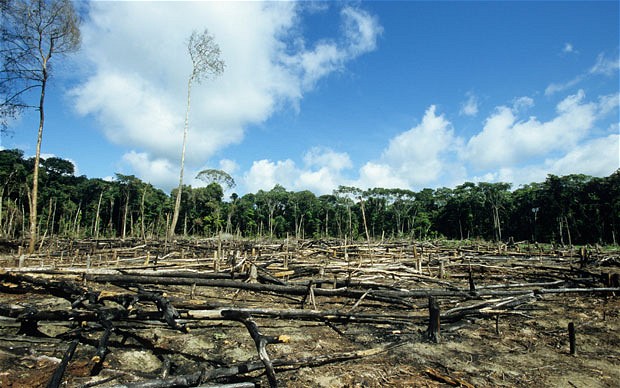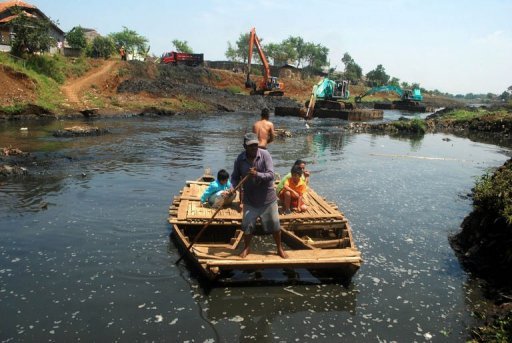Threats
Like many endangered species, no one activity is responsible for their decline, many areas of human actions be it direct or indirect have led to the Proboscis Monkeys fall in numbers. These include Habitat loss, Hunting, trade, pollution , natural disasters and lastly human distrubance.
Habitat Loss:
Proboscis monkey habitat is the most endangered among the types natural vegetation in Borneo mainly due to logging and agricultural needs(Rijksen & Meijaard, 1999). This coupled with the monkeys preference for coastal lowland forests, (most targeted for redevelopment). Development around the riverbanks holds great economic returns, people living in the surrounding areas view the river as a transportation line while Riparian forests are needed to be cleared for expansion agricultural plantations and villages hastening the rate of its decline. (Bismark and Iskandar 2002; Ma’ruf et al. 2005)
Therefore, with its wide ranging effects, habitat destruction has been identified as one of the major threats to the survival of the proboscis monkey (Salter & MacKenzie, 1985; MacKinnon, 1987; Meijaard & Nijman, in press).
What about the Nature reserves?
In Borneo, there is a steady trend whereby conservation areas are becoming isolated, and once healthy buffer zones are degrading (Cur- ran et al. 2004). Resulting in increasingly little protection to shield the animals from negative human influence.
In Sabah, only 15% of proboscis monkey groups are living in these areas. The others are split 50-50 living either out of range from the reserve network or within Permanent forest timber reserves (Sha et al. 2008).
In Kalimantan ,despite an estimated number of 5000 Proboscis monkeys living in protected areas, deforestation rates between protected and non-protected areas is negligible. (Curran et al. 2004).
For example, protected lowland forests in Kalimantan have shown a decrease over the years ( 56% from 1985 to 2001) with more than 50 % of the remaining protected low- land forests in Kalimantan overlapped with concessions and plantations (Curran et al. 2004). Places once set aside for conservation are being given away with timber concessions and plantations, mining is poisoning the rivers, and the forests are being cleared for agricul- ture (Meijaard & Nijman 2000, Curran et al. 2004, S. Lhota unpubl. data).
Thus living in these protected areas will not guarantee their long-term protection and without intervention, the decline of theProboscis Monkey population would only escalate further.
Hunting
In some areas, proboscis monkeys are wrongly assumed to be crop raiders and are subsequently poisoned. In others, they are hunted for food, as sport or even for bait or feed given to the resident reptiles (Bennett et al. 1987; Bennett 1988; Boonratana & Sharma 1992; Meijaard & Nijman 2000a; Soendjoto 2004). Their sleeping habits near rivers remains a fact, well known by would be hunters on boats. (Tuen & Pandong 2007). In some areas, hunting been identified as the culprit for the deterioration in the proboscis monkey population (Meijaard & Nijman 2000a).
Another one of the reasons that led to increase in hunting might be the proboscis value as a commodity in the trade industry. Proboscis monkey’s intestines secrete bezoar stones, a valuable ingredient in Chinese Medicine and besides that, there is a demand for them as exotic pets from collectors (Meijaard & Nijman 2000b), further perpetuating their decline.
And even when Proboscis Monkeys are not the ones being hunted, use of firearms in general, within their habitat has the potential to disturb them negatively (Tuen & Pandong 2007).
Pollution
Another culprit of the decrease in proboscis monkeys are said to be caused by increasing river pollution through gold mining activity and river traffic (Yeager 1992). Chemicals from mining and leaked petrol from motor-boats all flow downstream in direct contact with the animals habitat.
With the introduction of village settlement and factories upstream of Proboscis Monkey habitats, there has been a drastic fall in quality of river water, leading to polluted water, used by the animals for drinking, bathing and swimming. Studies have shown a spread of parasites in the river for areas that has undergone development. With Ascaris and Trichiuris egg worms found in faeces of the Proboscis Monkeys in the region. (Matsubayashi and Sayuthi 1981)
Natural Disasters
In seasons of drought, there can be a potential increase in forest fires that threaten the already dwindling habitat of the Proboscis Monkeys. This destruction though not occurring frequently, when coupled with destructive human activities, may prove to be a problem for the animals survival (Yeager 1992a).
One such case where fire has proven to be a significant threat to proboscis monkeys is in the Balikpapan Bay its effect was so great that it is estimated that eliminating the forest fires would aid the stabilisation of the population after 10 years. As even though mangrove forest may not be directly affected by fires, proboscis monkeys in Balikpapan Bay appear to be dependent on food sources from the non-mangrove areas surrounding it (S. Lhota unpubl. data).
Human Disturbance
With the development of settlements and mining activities along rivers, there is an increase in boat traffic. This may hamper the natural river crossing behaviours of Proboscis Monkeys which may then lead to a decline in population density and various group sizes. Also with increased river traffic, there is a significant increase in collisions of boats with the crossing animals which may further lead to their decline (Yeager 1992a).


